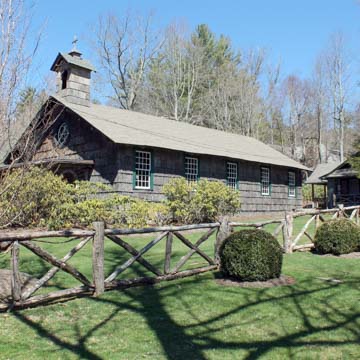All Saints Episcopal Church is a little gem of rustic architecture designed by Henry Bacon, architect of the Lincoln Memorial in Washington, D.C. It sits within the Linville historic core.
Situated at 3,800 feet, Linville began as an investment town of the Linville Improvement Company, headed by the MacRae family of Wilmington, North Carolina, sometime around 1889. The company purchased 16,000 acres in the Blue Ridge Mountains, including Grandfather Mountain. Plans changed, however, when the wives of the company directors saw the site and convinced their husbands to develop the town as a resort. On a visit in 1891, Harvard professor William James exclaimed, “At last, I have struck it rich here in North Carolina and am in the most peculiar and one of the most poetic places I have ever been in…the road through the forest, the view, the crags, were as good as such things can be.” The town grew in three identifiable phases: the early years of the 1890s to 1920, during which the town’s preference for chestnut-bark shingles and rustic details was established; the expansion from 1920 to 1940, which maintained a rustic sensibility; and the postwar era, when the effects of chestnut blight can be seen in the absence of the town’s characteristic shingles.
Designed using various parts of chestnut trees that once grew densely throughout the Appalachian Mountains, the All Saints Episcopal Church is constructed of unstripped chestnut logs and branches with chestnut shingle siding inside and out. The single-story, gable-roofed building faces west on Carolina Avenue, one block north of Eseeola Lodge at the center of historic Linville. The front facade has a low-pitched shed porch supported by log posts below a roundel of red and green circles in the gable, and topped by a short, square tower finished with a log cross. The entry door of simple vertical planks has two massive wrought-iron decorative hinges in an organic design.
Inside, All Saints reveals its High Church Episcopalian roots with its rood screen, a legacy from the medieval era no longer common in western Christian churches. The rood screen physically separates the four-bay-long nave—with its center aisle and double row of pews—from the chancel. The screen is made of chestnut logs and designed to visually frame the arched window on the eastern wall. Larger chestnut limbs woven into an open-truss system spans the church, blending structure and ornament in a visually dominant composition. Funded by Agnes Walter Parsley at the cost of $1,000, All Saints Episcopal Church represents the quintessential Linville aesthetic.
Henry Bacon knew the MacRaes from Wilmington, where he designed several Queen Anne cottages for the family. Bacon’s North Carolina work was different from the Beaux-Arts classicism for which he is famous; in the same years that he was designing the Lincoln Memorial, Bacon was also working on the All Saints Episcopal Church. Bacon had spent much of his youth in Wilmington, leading to many local commissions. In Linville, Bacon also designed a number of houses in the Rustic style.
While surrounding towns continued to develop and grow in population, Linville has managed to stay a quiet resort community. Through its use of chestnut, the church continues to pay homage to place and vernacular building traditions in a manner nearly impossible to replicate.
References
“Art/Community/Story.” The Episcopal Church and Visual Arts. Accessed April 15, 2014. http://www.ecva.org/.
“Bacon, Henry (1866-1924).” NC Architects & Builders: NCSU Libraries. Accessed April 22, 2014. http://ncarchitects.lib.ncsu.edu/.
Bishir, Catherine W., Michael T. Southern, and Jennifer F. Martin. A Guide to the Historic Architecture of Western North Carolina. Chapel Hill: University of North Carolina Press, 1999.
Bishir, Catherine W. North Carolina Architecture. Chapel Hill: University of North Carolina Press, 1990.
Roberts, Claudia, “Linville Historic District,” Avery County, North Carolina. National Register of Historic Places Inventory–Nomination Form, 1979. National Park Service, U.S. Department of the Interior, Washington, D.C.
Wrenn, Tony P. “Bacon, Henry, Jr.” NCpedia. Accessed January 28, 2019. http://ncpedia.org/.

